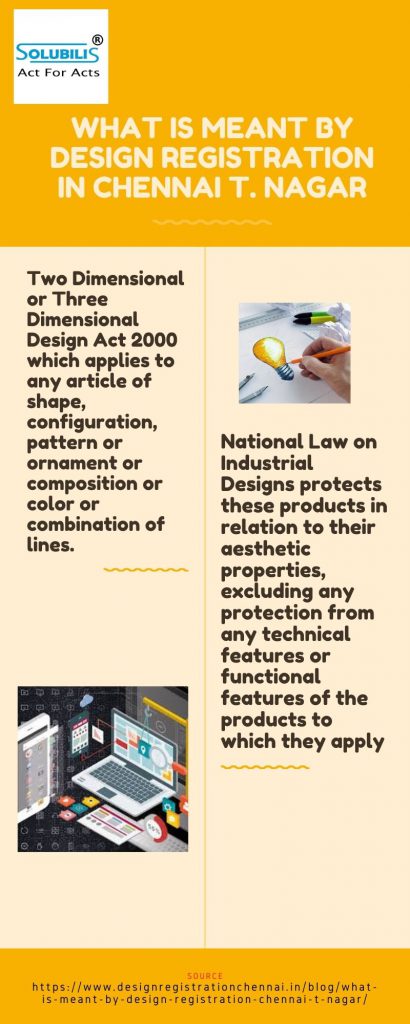TALK TO EXPERTS
Design registration in Chennai T.Nagar has mention under the Two Dimensional or Three Dimensional Design Act 2000 which applies to any article of shape, configuration, pattern or ornament or composition or color or combination of lines. Design registration in Chennai T.Nagar is similar to copyright registration, patent or trademark registration. And a kind of intellectual property registration – it protects the creation of the mind. In this article, we will review the basics of registered design in India. Design registration in Chennai T.Nagar specifies that design is the decorative or aesthetic element of an article. The purpose of the law is to protect the aesthetic shape and not the functional or functional shape. To obtain legal protection the definition requirements of Section 2 (d) of the Design must have consideration. By definition, Design registration in Chennai T.Nagar states that design “does not include any mechanical device that has any mode or structural principle or material.” .
The Escorts Construction Equipment Limited Vs Action Construction Equipment Pvt Ltd, 1999 PTC 36 (del), is a definition. The High Court of Delhi has context to understand part of this definition (as in the Designs Act, 1911). Pick-n-carry hydraulic self-made mobile cranes which had complete by the plaintiff appear to have the illegal copy by the defendant.
Although the case did not fall directly under the Designs Act, the court examined whether the design could be registered under the Designs Act. After examining the definition of design by law, the court held the design in question was incapable of registration. According to the court, the definition clarified that the primary object of the law is to protect the shape; and not the functional structure. Design does not contain a structure or properties or a method or formula of shape or configuration.
These had dictation only by the function to have performance on that shape or configuration. “The court rejected the plaintiff’s contention that certain parts of the crane had protection”. Furthermore the above-mentioned parts of the crane made in a certain shape so that they have mechanically interconnected with others. These parts of the crane not made to appeal to the eye but only for the crane to work. The most important parts or components that have not found on the crane have to pass a test that can handle their performance. They have determination by appearance and not by appearance. Consequently, the key components which had mention above not listed as designs”.

There are two types of design registration:
- Two Dimensional Creation: Patterns, lines or colors are added to products to give them a unique design without producing a technical effect.
- Three-dimensional creation (shape): It gives a unique look to its product without producing a technical effect.
The term “design” have description in Section 2 (d) of the Designs Act, 2000. The definition reads as follows:
But any mode or structural principle or substance shall not be merely a mechanical device and shall bear no trademark as defined in clause (v) of subsection (1) of section 2 of the Goods and Service. Any work of art as defined in Clause (c) of Section 2 of the Property Mark or Copyright Act, 1957 (14), as defined in Marx Act, 1958 (43 in 1958), or Section 479 (45 in 1860) of the Indian Penal Code. In 1957). ”

Design registration in Chennai T.Nagar can be applied to a wide variety of industry and commerce sectors, from complex equipment (machines, vehicles, tools, engines, computers, construction structures, etc.) to specific or everyday articles (for a variety of products). Such as clothing, footwear, jewelry, electrical appliances, toys and furniture). The National Law on Industrial Designs protects these products in relation to their aesthetic properties, excluding any protection from any technical features or functional features of the products to which they apply.

Legal Protection
When a new or original design has creation and above all, once it has been having application to a product and getting commercial, it is important to legally protect it if it is to achieve a certain level of commercial success. This is because, if a third party (usually a competitor) makes, uses or sells similar products that are confusing with the same design or the original, it is very harmful to the design creator.
The creator of the design not only invested financially to develop the design, but also took advantage of the competition in the market. If the design has no legal protection and, any third party may freely use and reproduce it. The initial financial investment and actual or potential competition in the market may have benefit or loss.
Finally, the importance of legally protecting a design is that it applies the commercial value that the design produces. In accordance with the Designs Act, once a design is registered, it gives the legal right to take action against the person (natural / legal entity) who violates the design right, not less than the District Court to stop such extortion and claim of any loss legally qualified by the registered owner.
If the design has no registration under the Designs Act, 2000, then any action against the violator is impossible. To enjoy legal protection as an industrial designer, the creator must apply to the design office for design registration. If the design is new it can have protection. According to most national laws on industrial designs, the design must be original rather than new.
Ways of protection
The design can be protected in a variety of ways. On the one hand, it may have protection under the right to industrial property. On the other hand, it may have protection under intellectual property or copyright law.
Similarly, in some cases the design has protection under unfair competition law. In this case, the scope of protection, design copyright, legal protection are different from those applicable under industrial property law.
Industrial property
Under industrial property laws, a design has protection as follows:
-
Industrial design:
Added to it to have access to this type of protection the design must be new or original; or can have application to a product that has a useful function.
-
Trademark
The Trademarks Act, 1999 had an enact in 2003 and the definition of a trademark. Expanded to include “shape of objects” under section 2 (1) (zb), no modification of the meaning of the design. In the Designs Act 2000 to remove the definition of a trademark under the new-bizarre trademark law.
